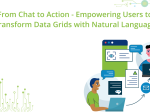A Step-by-Step Guide To UI Components
If you’re getting into app development, UI components are a total game-changer. They’re like little Lego pieces — buttons, charts, and sliders — that you can reuse to keep your design consistent and your code organized. Whether it’s React UI components or other JavaScript UI components, they make building apps much easier and more efficient. UI design tools in software development help developers and designers create user-friendly, visually consistent interfaces faster by providing ready-made components, templates, and collaborative design environments.
Ext JS provides a rich set of mobile UI components JavaScript, enabling developers to create responsive and interactive interfaces across devices effortlessly. Build faster, user-friendly, and inclusive apps in 2025 with accessible React UI components — pre-built, responsive, and WCAG-compliant elements that ensure every user gets a seamless experience.
With such ready-to-use components, developers can focus more on delivering great user experiences instead of spending time reinventing the basics.
A UI component is basically a small chunk of functionality, like a login form or a grid, that you can drop into different parts of your app. This is where a good UI library makes life easier. Something like Ext JS gives you ready-to-use JavaScript components, stuff like calendars, trees, and data views. You don’t have to build all that from scratch. It saves time and lets you focus on the fun part: actually building your app.

If you’re using React, you’ve probably seen tons of UI components out there. Need a button? A full dashboard? There’s a React component library for that. The best ones make life easier, faster, and easier to drop in. Honestly, good UI libraries save time and just make building stuff way smoother.
So, the choice of the right tools really matters whether you’re using JS UI components or exploring UI React components. The goal is to build faster, efficient, and better interfaces with the help of powerful UI component libraries.
Why Do You Need a UI Component Library?
Creating a smooth UI from scratch takes a lot of time and resources. That’s the reason UI libraries are very convenient for building interfaces. These frameworks pack tons of pre-built stuff like buttons, forms, and all the essentials. No need to reinvent the wheel. Just pick what fits your design, drop it in, and you’re set.
Take the Ext JS Kitchen Sink, for example. It’s packed with all kinds of JavaScript UI components, from simple login forms to advanced charts and data grids. You can drag, drop, and customise to fit your app’s needs. That means faster development and more consistent design.
If you’re working in React, you’ve got even more great options. React libraries like Material UI and Chakra UI are popular for a reason. Material UI follows Google’s design style, while Chakra prioritises accessibility and flexible components. Both offer React UI components that are production-ready and easy to tweak.
The best part is that these libraries save you hours of styling and testing, all while keeping your app visually consistent. Whether you’re after the best UI library for React or just a reliable React UI component library, these tools give you a solid head start and a cleaner codebase.
What Are UI Components Capable of Doing?
UI components are the basic pieces that make up your app’s interface. They control everything from simple buttons to complex features like drag-and-drop or movable panels. Every interactive element you see – menus, popups, toolbars – they’re all built using these components behind the scenes.
Most of the time, these components are part of a bigger structure. For example, in frameworks like Sencha, every component is a child of a base component like Ext.Component. That just means they inherit core behaviours, which saves you from writing the same code over and over. It’s all about reusability and keeping things consistent.
When it comes to React, things get even cooler. React UI components are super modular. You can build them as functional or class components, and they work independently. They take in props (which are just inputs) and return elements that decide what shows up on screen.
Thanks to the power of a strong React UI component library, you can mix and match these little blocks to create complex UIs with less effort. Whether you’re using JavaScript UI components, React UI libraries, or picking the best React ui library, having a solid UI component library just makes development smoother.
How to Start with Button Components?
Initiating your journey with UI components can begin by incorporating a simple element like a button. The Button component is a fundamental UI component that often works in tandem with other components. For instance, a button can navigate users to another page or trigger specific actions upon being clicked. However, button components can also offer advanced functionalities. In Ext JS, Button components include variations such as buttons containing links, menu buttons with dropdown menus, split buttons with icons and texts, and segmented buttons. Starting with these simple components provides a solid foundation for understanding how more complex UI components function when integrated into your applications.
Need great-looking buttons fast? React libraries like Material UI and Chakra UI come packed with ready-to-use button components. You can tweak them to match your app’s style perfectly. Best part? They help keep your design consistent while still letting you customise for different user needs. Just plug them in and go!
What Do You Need to Do to Bind Data with UI Components?
Once you’re comfortable adding UI components to your application, the next crucial step is data binding. Data binding is essential for making components behave dynamically based on the underlying data. In Ext JS, dynamic data binding allows you to link data to components using configurations. This linkage ensures that when one bound component changes, related components update automatically.
Data binding can encompass connecting formulas, binding associations, changing states, chaining combo boxes, and chaining selections. Additionally, remote data binding enables components to fetch and display data from external sources, enhancing the application’s interactivity and responsiveness.
In React, data binding is all about using props and state. Props let you pass data from one component to another, usually from parent to child. State, on the other hand, is how a component keeps track of its own data. Thanks to React’s one-way data flow, updates move in a clear, predictable direction, which helps keep your app easy to follow and debug.
Most React UI component libraries are built with this in mind. These UI component libraries offer ready-made React UI components that play nicely with tools like Redux or the Context API. If you’re using a React UI component library, data binding often feels almost automatic, and that’s a big win for developers.
Also Read: Top Mistakes Developers Make When Using React UI Component Library (And How to Avoid Them)
How Can You Use Grid Components?
Grid components are great for apps that need to handle a lot of data. They have a facility to display huge datasets. Think millions of rows shown in the browser without compromising performance. Pretty cool, right?
Grids are not just about showing data. They give you all the useful features like filtering, sorting, pagination, and even built-in data visualisations. Take the Ext JS grid library, for example. It’s packed with goodies like editable rows, expandable rows, and smart cell editing. You can even work with pivot grids to crunch numbers and present complex data in clean, digestible tables. That’s a win for building dashboards and apps that deliver real business insights.
Now, if you’re working with React, there are some solid options in the React UI component library space. Material UI and Ant Design are some of the libraries that make it super convenient to build efficient, interactive tables. These React UI components come with built-in support for things like virtual scrolling, resizable columns, and live data updates.
Whether you’re using JavaScript UI components in general or a React UI Component Library, these tools help you create fast, responsive, and powerful interfaces. And when you pick from the best UI library for React, your users get a smoother, smarter experience. That’s the real value of modern UI component libraries.
How to Start Visualising Data?
Once you’re comfortable with the basics of UI components, it’s time to level up by turning your data into visuals. Charts are the best and easiest way to have a clear picture of what is going on. There are different types of charts, each has its own representation, like Bar charts, pie charts, line graphs, etc.
If you’re working with Ext JS, you’re in luck. It comes packed with UI components made just for data viz. You’ve got everything from basic bar and line charts to more advanced stuff like stacked columns, radar charts, 3D graphs, and even gauges. Pretty handy when you need to show complex data in a simple way.
For React folks, libraries like Recharts, Victory, and Nivo make life easier. These are solid React UI component libraries built specifically for data visualisation. They plug right into your app, let you bind data easily, and offer lots of cool, interactive charts out of the box.
Using these JavaScript UI components helps your app feel more alive. It’s not just about looks—it’s about helping people understand data faster. And honestly, having the right UI component library makes all the difference when building charts that work and look good.
Are You Ready to Get Started with Ext JS UI Components?
Using Ext JS UI components as examples, this article has explored the basics of UI components, from React UI component libraries to components for data visualisation. UI components are integral to modern web applications, enabling developers to reuse the same web elements across all UIs within their applications. UI libraries in Ext JS, such as grid and chart components, are versatile tools suitable for a wide range of tasks. In essence, they simplify and accelerate the development process. So, embark on building powerful UIs with Ext JS UI Components!
Exploring Top React UI Component Libraries
In the React ecosystem, several UI component libraries have emerged as favourites among developers:
- Material UI: Implements Google’s Material Design, offering a comprehensive suite of components with robust customisation options.
- Chakra UI: Known for its simplicity and accessibility, providing modular and customisable components that enhance developer productivity.
- Ant Design: It is a go-to for business apps, packed with polished, ready-to-use components and design tools that just work.
- React Bootstrap: Lets you use Bootstrap’s UI elements directly in React. Now you can build interfaces faster by treating Bootstrap components like native React components – no messy conversions needed.
- PrimeReact: It gives you tons of free, ready-to-use React components. It comes packed with different themes and templates to jumpstart your projects.
These React UI component libraries not only expedite the development process but also ensure a consistent and polished user interface across applications, making them a go-to choice when you’re looking for the best UI library React developers rely on.
FAQs
What is a user interface?
A user interface is all about how people interact with or use an app or a website. UI consist of different components like buttons, menus, and sliders, basically the stuff you click or tap. A clean, simple interface just works better. When your app responds instantly without hiccups, you’ll know you’ve nailed it – everything flows naturally.
What is UI and UX?
UI is all about how things look, like the layout, colours, and buttons. UX is more about how it feels to use, whether it’s smooth or annoying. UI catches the eye, UX keeps people around. You kinda need both working together if you want your app to actually feel good to use.
What is a component library?
Think of a component library as a toolbox full of ready-made UI components like buttons, pop-ups, tables, and forms that you can reuse throughout your app. It keeps your design looking sharp while saving you from rewriting the same code over and over. Popular ones include Material UI, Chakra UI, and Ext JS.
How to create a user interface?
Building a UI starts with sketching layouts and picking elements like buttons, forms, and whatever users need. First, mock it up in Figma, then code it with React or Angular. Most developers use ready-made component libraries to save time. The goal is to make everything intuitive so users know exactly how to interact with your app without thinking.
What is a command user interface?
A command user interface (CUI) allows the user to use commands instead of graphic components for interaction with the system. Think of terminal or command-line interfaces where users type instructions instead of clicking buttons. It’s powerful for advanced users but not as beginner-friendly as graphical UIs.
What is user interface testing?
User interface testing is used to ensure the expected working of all the components used in designing the interface. It ensures that buttons click, forms submit, dropdowns work, and pages render correctly on different devices. This testing helps catch visual bugs and usability issues before users do.
What are UI benefits?
A great UI keeps users hooked and makes your app easy to learn. It works for everyone, stays on-brand, and helps people get things done faster with fewer mistakes. Basically, good design just makes everything work better.
How to build a UI component library?
First, spot repeatable elements in your app – buttons, cards, popups. Build these as independent components using React/Vue. Keep them flexible and easy to tweak. Don’t forget clear docs! Tools like Storybook help display and test components alone. Boom – you’ve got a reusable toolbox for future projects.
What is a component in React?
Think of React components like building blocks; each one is a standalone component of UI, from simple buttons to entire forms. They make your interface modular (reuse them anywhere) and way easier to maintain. You can write them as simple functions with hooks or as class components, your choice.

The Ext JS Data Grid is widely regarded as one of the most feature‑rich and…

The integration of LLMs into Web application development has moved well beyond simple content generation…

ReExt is a React library developed by Sencha that allows you to use Ext JS…









